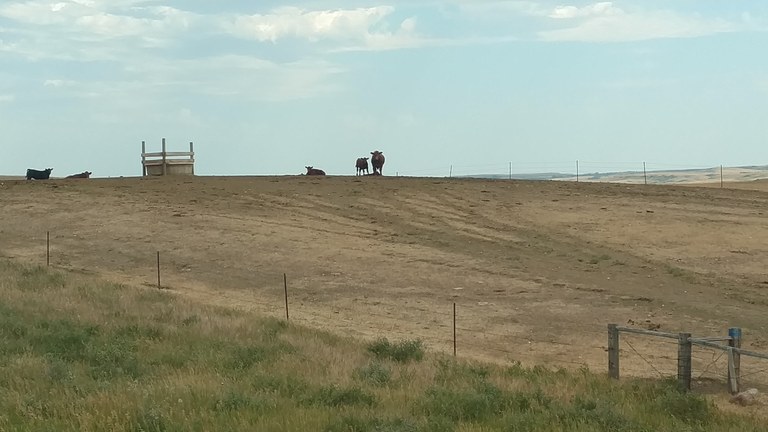In a Drought? --- Go drylot for the cows!
The Carrington Research Extension Center has a cow calf herd that has been in drylot for over 30 years. They don’t go to grass pasture.
If ranchers are considering options during a drought when the pasture or range is almost grazed off, they can consider drylotting, the cows. Drylotting refers to raising or feeding cattle in a pen where feed, water and bedding are provided to the cattle. Cows and calves are fed a nutritionally balanced ration every day. Drylotting works extremely well: a visit to the CREC Livestock Unit provides visual proof that management and feeding skills are available to maintain a productive cow-calf herd.
The CREC cow herd is used for numerous feeding trials. Retired Animal Scientist Vern Anderson researched many co-product feeds during his tenure at the center. These co-product feeds – like wheat midds, distillers grains, barley malt sprouts, beet pulp - are produced in North Dakota and are now widely used in cattle rations. These feedstuffs are currently available during this year’s drought. For listing of coproduct produced in North Dakota go to: https://www.ag.ndsu.edu/drought/feeds-and-feeding/sources-and-prices-for-selected-co-products-produced-in-nd.
Calf weaning weights and cow pregnancy rates are similar to pastured cattle if the ration for the drylot cow herd is matched to the cows and calves’ production needs.
Anderson and coworkers reported on a comparison of the CREC cow herd when drylotted or taken to pasture for 6 months over a 3 year period. Conception rates were similar between drylot or pasture fed cows. Calf weights were lighter for the drylot cows however, drylot cows also lost more weight that the pasture cows during lactation. This suggests that the ration provided to the drylot cows in this experiment contained less available energy and other nutrients than the pasture grazed cattle. To review the report go to: https://www.ag.ndsu.edu/CarringtonREC/documents/livestockrd/docs2013/2013-drylot-vs-pasture-beef-cow-calf-production-3-year-progress-report/view.
Feeding cows and calves in drylot had a higher cost as compared to pasture costs during this study that was conducted in a non-drought weather cycle. However, during a drought when pasture is not available, the alternative is to sell cows, feed cows on pasture, or feed cows in drylot.
The CREC's cow herd is a good example of alternative management for cow herds. Excellent information to consider during a drought.

If your pasture looks like this, it’s time to consider drylot feeding management.
Karl Hoppe, Ph. D.
Karl.Hoppe@ndsu.edu
Area Extension Livestock Specialist


